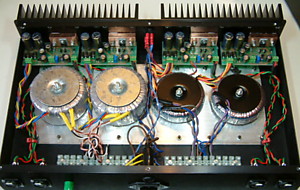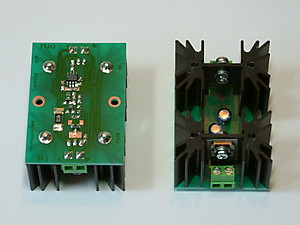Paul Hynes Design
Paul Hynes manufactures a range of advanced regulated power supplies for high-end audio, both as complete units and as OEM and DIY modules. In this interview, John Reekie talks to Paul about his product range. We look forward to a future technical article from Paul on application of his modules.
JR – Paul, glad to be able to speak with you about your power supplies and modules. Without getting too technical in this interview, could you tell us the scope of your product range?

PH – My product range is quite wide now, with many more options than shown on the old website. (The new website is in preparation and all the new products will be described when the site is posted.) People keep asking me for power supply solutions for all sorts of equipment and I can usually customise power supplies or regulator modules to suit the different applications of my customers. For instance I am currently preparing a linear regulated ATX power supply with my best regulation topologies, for one customer, for use with his audio server motherboard. I have other products besides power supplies. I also provide a remote control solution for George Stantscheff’s Lightspeed volume control, with his blessing of course, and I am about to release my latest phono stage for vinyl replay.
JR – I’m looking forward to a future technical article with details of how to use some of these. Briefly, though, are they largely used in scratch-built projects, or in modifications to existing products?
PH – The modules are used for scratch build as well as modification projects. The built power supply range is usually set up for plug and play with custom DC leads to replace external equipment power supplies.
JR – Are any manufacturers of complete units using your modules?
PH – Disregarding my consultancy contract users, governed by non-disclosure agreements, there are several well-known equipment manufacturers and modification businesses setting up trials of my regulator modules at present, as well as several more awaiting modules.
JR – Many of your regulators are available in both series and shunt versions. Would you generally recommend using a shunt regulator if idle current and thermal dissipation considerations allow, or are there more complex reasons to prefer one over the other?
PH – There are more complex reasons for the regulator topology choices. The design choices have to consider supply line rejection, operating bandwidth, transient response and settling time when responding to load current changes, stability, noise, thermal engineering, etc. I am planning on discussing these issues in a future article.
JR – How popular are your three-terminal regulator replacements? Is it always true that replacing a standard regulator in existing equipment with one of yours will result in audible sonic improvements, or are there times when it might not?

PH – Provided the correct regulator topology/performance is chosen for the replacement there is usually a very noticeable improvement. Obviously the overall system transparency will dictate just how much improvement you are going to hear. I have a return-if-not-satisfied policy and, so far, no one has returned any of my regulator modules because they did not get a worthwhile audible improvement. This is not just against stock three-terminal regulators, but other specialist power supply products as well. In fact over the last five years of supplying these modules only one person has returned a set of mini shunt regulators because they could not provide enough current for his particular project due to thermal limitations. I offered higher power modules but the person he was building for did not want to wait for the replacements. This is one of the reasons I like to discuss my customer’s proposed applications thoroughly, to ensure that I recommend the right regulator/power supply for their application.
JR – Do you recommend also replacing capacitors and/or diodes in a power supply when installing one or more of your three-terminal regulators?
PH – Cost considerations aside, careful choices with diodes/capacitors can bring further benefits especially with reducing diode switching noise and ensuring quality energy storage.
JR – If I understand correctly, your CCS1a constant current source can be used in place of the anode resistor in a common-cathode tube gain stage? Is it always beneficial to use one?
PH – Replacing the anode resistor of a common cathode tube stage with a constant current source has a profound effect on the operating characteristics of the tube. Firstly the improved supply noise rejection means less supply noise gets into the signal path and this can be very beneficial, particularly with low-level information transfer. Secondly, instead of the tube behaving like a modulated current source with a resistive load, it behaves like a modulated resistor with a constant current load. I do not know if every tube would like this mode of operation, but the tubes I have used in this way, that have shown improved audible performance, are the 6DJ8/ECC88/6922, 12AX7/ECC83, 12AU7/ECC82, 12AT7/ECC81, 6SL7, 6SN7, 6AS7, 2A3 and 300B. Expect to hear improved dynamic scale and image stability as well as lower overall distortion.
JR – And what about power amps? How is it used there?
PH – For single-ended output stages the CCS1a replaces the anode load and the anode is then coupled to the output transformer via a high quality film capacitor. Done this way the transformer no longer needs an air gap, as there is no DC current running through the transformer primary.
For push-pull output stages, a pair of output tubes set up as a differential pair with their cathodes connected together can use the CCS1a to supply a constant current to the cathodes. The output transformer is used as normal in this configuration.
JR – I suppose I should have asked this first, but – how did you come to be interested in high-end audio?
PH – I used to play in pop/rock bands as a teenager and I had friends who played in folk groups. I was often disappointed with recorded music replay at home when compared to attending live music, particularly pure acoustic music. At this time my cousin was a very popular DJ on the Manchester circuit and he used some classic equipment on the road like Tannoy loudspeakers and a Sansui valve amplifier/receiver. He also ran a club in Manchester and used Voice of the Theatre horns there. Without fail he always produced a musically enjoyable sound so I knew more was possible compared to my home equipment. I decided that I had to work on my system to enable the performance to move closer to the live music I was so often hearing at live acoustic gigs. It’s been an obsession ever since.
JR – What about music – any special favorites for you at the present time?
PH – I was a teenager during the dawn of the supergroups, like Cream, Led Zeppelin, Yes, Pink Floyd, etc, and I always have a soft spot for their music although not all of their later works. My cousin’s father also sparked an interest in classical music at this time, as he had quite a collection, so I listen to classical often. I also like jazz and folk music. My choice of the moment is governed by mood.
Manufacturer’s website
http://www.paulhynesdesign.com/



